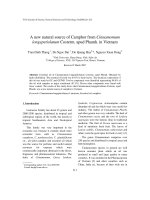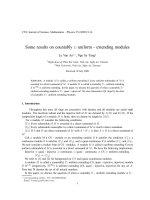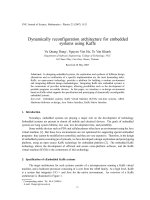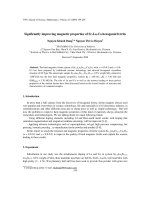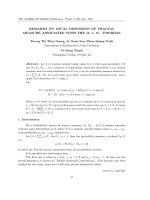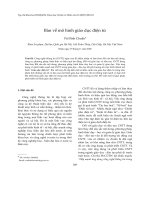Tài liệu Báo cáo " Signficantly improving magnetic properties of Sr-La-Co hexagonal ferrite" doc
Bạn đang xem bản rút gọn của tài liệu. Xem và tải ngay bản đầy đủ của tài liệu tại đây (207.65 KB, 7 trang )
VNU Journal of Science, Mathematics - Physics 25 (2009) 199-205
199
Signficantly improving magnetic properties of Sr-La-Co hexagonal ferrite
Nguyen Khanh Dung
1,
* Nguyen Thi Le Huyen
2
1)
HoChiMinh City University of Industry
12 Nguyen Van Bao, Ward 4, Go Vap District, Hochiminh city, Vietnam
2)
Institute of Physics in HoChiMinh City, 1 Mac Dinh Chi, 1 District, Hochiminh city, Vietnam
Received 5 September 2009
Abstract: The hard magnetic ferrite system of Sr
1-
x
La
x
Fe
12-
y
Co
y
O
19
with x = 0.0-0.3 and y = 0.0-
0.3 has been prepared by traditional ceramic technology and showed hexagonal crystalline
structure of M-Type.The anisotropic sample Sr
0.8
La
0.2
Fe
11.7
Co
0.3
O
19
+ 0.5% weight SiO
2
sintered at
1280
o
C/2h has the best hard magnetic properties, namely B
r
= 4.66 kG;
B
H
C
= 3.46 kOe and
(BH)
max
= 5.70 MG.Oe. The role of La and Co as well as the reasons leading to these perfect
properties of the studied ferrites have been discussed based on the overall studies of structure and
characteristics of examined samples.
1. Introduction
In more than a half century from the discovery of hexagonal ferrite, ferrite magnets always used
very popular and everywhere in science, technology, life and especially in civil electronics industry, in
communications and other different areas due to cheap price as well as simple technology. But still
now the problem to improve hard magnetic properties of this kind of materials always attracted the
researchers and technologists. We are talking about two main following trends:
- Using different doping elements including 3d and Rare-earth metal oxides with hoping that
saturation magnetization and magnetocrystalline anisotropy will be improved [1-4].
- Applying advance technologies such as coprecipitation, sol-gel, high pressure compressing, hot
pressing, isostatic pressing to manufacture ferrite powder and product [5-8].
In this report we study the structure and magnetic properties of ferrite system Sr
1-
x
La
x
Fe
12-y
Co
y
O
19
(x = 0.0-0.3 and y = 0.0-0.3) to improve the quality of hard magnetic ferrite and explain the reasons
leading to these results.
2. Experiment
Substitution in our study was the simultaneous doping of La and Co in system Sr
1-
x
La
x
Fe
12-
y
Co
y
O
19
+ 0.5% weight of SiO
2
. Raw materials used here are SrCO
3
, Fe
2
O
3
, La
2
O
3
, CoO and SiO
2
with
high purity (3 - 4 N). Wet planetary ball mill has been used to provide fine powder with grain size
______
*
Corresponding author. E-mail:
N.K. Dung, N.T.L. Huyen / VNU Journal of Science, Mathematics - Physics 25 (2009) 199-205
200
around 1μm. The ratio between powder: ball: water was 1: 4: 1. We kept the moisture of powder about
35% for anisotropic pressing. To orientate the particles along the magnetic field, the field strength of
1T and the pressure of 500 kG/cm
2
have been applied. The samples were sintered at temperatures
1260
o
C, 1270
o
C, 1280
o
C and keeping time was 2h. Approximately, the chemical composition of
samples was checked by EDS facility. The thermal transitions were performed by DTA- DTG
machine. The crystallographic structure of samples was examined by X-ray diffractometer (Siemens
D5005 X-ray, Germany). Microstructure of isotropic and anisotropic samples has been studied using
SEM (JEOL-JSM5410LV, Japan). Magnetic properties are investigated by VSM (200C Nim, USA),
hysteresisgraph (AMH50-20, USA) and magnetometer using high pulse magnetic field to measure
SPD curve.
3. Results and discussion
Fig. 1 shows demagnetizing curves of Sr-La-Co anisotropic samples sintered at 1280
o
C/2h . The
main characteristics derived from this figure are presented in Table 1.
Table 1. The main hard magnetic parameters of anisotropic samples sinterd at 1280
o
C/2h
Sample Compound
B
r
[kG]
B
H
C
[kOe]
J
H
C
[kOe] (BH)
max
[MG.Oe]
M1 SrFe
12
O
19
4.60 2.15 2.45 4.78
M2 Sr
0.8
La
0.2
Fe
12
O
19
4.58 2.73 2.73 5.34
M3 Sr
0.7
La
0.3
Fe
11.9
Co
0.1
O
19
4.50 2.90 3.25 5.60
M4 Sr
0.8
La
0.2
Fe
11.7
Co
0.3
O
19
4.66 3.46 3.60 5.70
strain and I
S
is saturation magnetization. The first term in expression (1) relating with
magnetocrystalline anisotropy and normally plays a decided role for creating high coercivity of
It is clearly seen from this table that with
appropriate substitution of La and Co, the
magnetic characteristics of sample M4 evidently
improved in comparison with pure hexagonal
ferrite M1, namely
B
H
C
increased up to 60% and
(BH)
max
achieved the record value of 5.70 MG.Oe.
To understand the reasons leading to so very high
quality of this sample, we remember that for
materials consisting of single domain particles, the
magnetizing process is the rotation process of
magnetization vectors of domains and coercivity
should be determined by expression:
( )
S
S21
S
1
C
I
λτ
cINNb
I
K
aH +−+=
(1) [9]
Here a, b and c are contants, K
1
is
magnetocrystalline anisotropic constant, N
1
and
N
2
are demagnetization factors determined
parallel and perpendicular to the axis of particles,
λ
is magnetostriction,
τ
is mechanical
0
0.5
1
1.5
2
2.5
3
3.5
4
4.5
5
-3.5-3-2.5-2-1.5-1-0.5 0
Coercivity (kOe)
reducial Inductio (kG)
M1
M2
M3
M4
Fig. 1. Demagnetizing curves of anisotropic
samples M1- M4.
N.K. Dung, N.T.L. Huyen / VNU Journal of Science, Mathematics - Physics 25 (2009) 199-205
201
materials
. For this reason almost authors focusing to find the way for increasing K
1
of hexagonal
ferrite mainly by substitution effects. The second term in (1) dealing with shape anisotropy of particles
forming material and takes part of several tens percent of H
C
and finally the last term in (1)
determined by magnetic elastic energy and often is small and could be ignored. Apart from above
indication, the general orientation to improve hard magnetic properties of hexagonal ferrite is to make
raise magnetocrystalline anisotropy, shape anisotropy of particles as well as saturation magnetization
Constant K
1
was measured in magnetometer with high pulse magnetic field using special point
detection (SPD) technicque. Fig.2 shows the measurements of M(H) curve and d
2
M/ dH
2
(H) curve for
sample M4 .
Measured results from Tab.2 showed the value K
1
= 3.6.10
5
J/m
3
for pure SrM ferrite which is
completely agreement with the results given by other authors, for example [5, 10, 11]. Note that ferrite
LaFe
12
O
19
has K
1
= (10-13) .10
5
J/m
3
at 0K [12], whereas ferrite CoFe
2
O
4
has K
1
= 3.9.10
5
J/m
3
at
room temperature [13]. H. Zijlstra [14] pointed out that in La-Co ferrite anisotropic field H
a
could
reach the value of 10
5
A/m and K
1
= 5.10
6
J/m
3
.
Thus with the simultaneous substitution of La for Sr and Co for Fe in the SrM-ferrite hard
magnetic properties of hexagonal ferrite significantly improved.
The crystallographic structure of samples has been examined by diffractometer and the XRD
patterns of samples M
1
, M
3
and M
4
are presented in Fig.3. The results indicated that the structure of
studied ferrite corresponding to magnetoplumbite structure with c-axis is a little longer but a-axis is
shrinked a little in comparison with pure SrM-ferrite as shown in Tab.3
Table 2. Constant K
1
of samples M1 and M4 derived
from SPD measurement
Sample K
1
x10
5
[J/m
3
]
M1 3.60
M4 3.93
Table 3. Lattice parameters of studied SrLaCo-M
ferrites
Sample a [Å] c [Å]
M1 5.8868 23.0370
M3 5.8775 23.1034
M4 5.8740 23.1091
0
1
2
3 4
H (T)
M (emu/g)
Fig. 2. M (H) curve (left) and
(
)
2
2
dH
HMd
curve (right) of sample M4 sintered at 1260
o
C/2h.
Sample
M1
80
70
60
50
40
30
20
10
0
H
a
parallel
M (emu/g)
120
110
100
90
80
70
60
50
40
30
20
10
0
H
a
perpendicula
r
parallel
0 1 2 3 4 5 6
H (T)
N.K. Dung, N.T.L. Huyen / VNU Journal of Science, Mathematics - Physics 25 (2009) 199-205
202
Fig. 3. X-ray diffraction patterns of the samples M1, M3 and M4 sintered at 1260
o
C/2h.
From Tab.3 we can conclude that by substitution in our study the unit lattice has more shape
anisotropy with longer needle form.
To understand about particle size of fine milled SrLaCo-ferrite, the powder was measured by
Microtrac machine S3000 and the results are indicated in Tab.4. It is clearly seen that in samples M
1
-
M
3
almost the particles have small size and especially by optimal substitution in sample M
4
, 100% of
particles has single domain structure with high shape anisotropy (Tabs. 3 and 4).
Table 4. Crystal grain size of SrLaCo- ferrite, which was presintered and fine milled
Sample M1 M2 M3 M4
Crystal grain size
[μm] (ratio)
33.69 (5%)
1.55 (54%)
0.39 (41%)
30.93 (3%)
1.62 (54%)
0.39 (43%)
26.33 (7%)
1.69 (58%)
0.41 (35%)
1.59 (46%)
0.37 (54%)
A further demonstration on the role of La and Co substitution is the microstructure observation
Figs. 4 and 5 show the SEM pictures of the samples. From both figures we can see the influence of
substitution to make finer and more homogeneity of particles which are correspond to single domain
structure. It is also obviously seen from Fig. 5 that the appropriate substitution (and small doping of
SiO
2
) not only restricting the grain growth but making the more shape anisotropy of them and both
these factors leading to enhance the hard magnetic properties of studied samples.
Our purpose is not only to achieve high H
C
but also to reach high value of magnetization. To find
the solution for this problem, almost the authors focusing on the way to make increase up-spin of
positions 2a and 2b. About the role of La to improve hard magnetic properties of hexagonal ferrite, the
Vietnamese researchers have published a large number of publications among them several has been
occured on the International Journals [15 -18].
In order to understand and discuss on the advance of La and La-Co as well as applied technology
of authors inside and outside Vietnam we derive here some main related results:
- In previous our work [14], the structure and magnetic properties of ferrite (SrO)
1-x
(La
2
O
3
)
x/2
.
5,3(Fe
2
O
3
) + 0.5% weight SiO
2
(x = 0.00 to 0.12) have been detailly investigated. The new technology
was applied there, namely the wet isostatic pressing was performed in a rubber die pressing. By that
tool we have succeded to prepare anisotropic samples with very high density (d>99%d
X
) and very
high orientation degree of particles along magnetizing field applied in pressing process and we have
30
31
32
33
34
35
2θ
80
70
60
50
40
30
20
10
0
Lin (Cps)
M4
M3
M1
M1
M3
M4
N.K. Dung, N.T.L. Huyen / VNU Journal of Science, Mathematics - Physics 25 (2009) 199-205
203
received ferrite sample with record quality for quite long time: B
r
= 4.3 kG;
B
H
C
= 3.2 kOe, (BH)
max
=
5.5 MG.Oe).
It is well known that the Fe
3+
ions which are origine of magnetic moment of hexagonal ferrite
normally located at 2a, 2b and 12k positions (up-spin) and 4f
1
and
4f
2
positions (down-spin) in the
crystallographic lattice. Therefore magnetic moment of a molecule SrO.6Fe
2
O
3
is equal to 20μ
B
.
The substitution of La for Sr leads to the following change:
Sr
2+
+ Fe
3+
La
3+
+ Fe
2+
(2)
The performed ions Fe
3+
possibly are located at 4f
1
and 4f
2
positions (down-spin) and because ion
Fe
2+
has smaller magnetic moment than of ion Fe
3+
, this valency conversion led to the increase of total
magnetization of ferrite.
- Se-Dong Yang et al. [19] studied two compositions SrFe
11.7
Co
0.3
O
19
and Sr
0.7
La
0.3
Fe
11.7
Co
0.3
O
19
and showed that Co alone enhanced B
r
but both La and Co improved H
C
.
- R. Grössinger et al. [20] indicated that the simultaneous replacement of La and Co in SrM -
ferrite notably increased H
C
due to increasing of anisotropic field H
a
and especially they also helped
stabilize H
C
on temperature but one necessary thing is the replacement fractions are not exceeded 0.25
mol.
- K. Masuzawa et al. [21] have studied ferrites Sr
1-
x
La
x
Fe
11.7
Co
0.3
O
19
and showed that with x =
0.3-0.4 ferrites have phase M. When x <0.3 H
C
becomes lower due to spinel phase (Co-ferrite) existed
and while x> 0.4 magnetic properties of ferrite strongly decreased, particularly for the remanent
induction B
r
because of occurring hematite phase.
- Y. Kubota et al. [2] examined ferrite system (Sr
2+
1- x
La
3+
x
)O .n{(Fe
3+
1- y
Co
2+
y
)
2
O
3
} where x =
2ny and n = 5.4-6.0 and showed that by substitutions of La for Sr and Co for Fe, respectively,
J
H
C
of
ferrite is significantly increased while B
r
only slightly enhanced (
J
H
C
= 4.5kOe; B
r
= 4.4kG). The
M1
M4
Fig. 4. SEM Images of isotropic bulk samples M1-M4
sintered at 1260
o
C/2h (bright line is10 μm).
M1 M2
M3 M4
La
Sr
Fig. 5. SEM Images of anisotropic bulk samples M1, M4
perpendicular (left) and parallen (rigth) to the preferred
magnetizing direction (bright line is 10 μm).
M1
M4
N.K. Dung, N.T.L. Huyen / VNU Journal of Science, Mathematics - Physics 25 (2009) 199-205
204
authors explained that the residual orbital magnetic moment of ion Co
2+
plays the main role to make
high value of H
C
.
- F. Kools et al. [22] studied ferrite system Sr
1-x
La
x
Fe
12-x
Co
x
O
19
(x <0.25) and indicated that Co
plays the important role for notably improvement of H
a
(i.e H
C
) and ions Co
2+
possible located 12k
and 4f
2
positions. They also showed that remanent induction could be determined by expression:
B
r
= s (d / d
o
) fJ
o
S
(3)
where s is ferrite fraction in the solid body, f is alignment factor, d and d
o
are experiment and
theoretical density, respectively, J
o
S
is saturation magnetization. Beside J
o
S
is intrinsic parameter, the
others are extrinsic ones and strongly depend on the technological processes.
According to our knowledge, recently maximum energy product obtained in this report belongs to
the highest value and very closed to the theoretical prediction.
4. Conclusion
By optimal substitution of La for Sr and Co for Fe in SrM hexagonal ferrite and used appropriate
technology, the studied anisotropic sample Sr
1-
x
La
x
Fe
12-y
Co
y
O
19
(x = 0,2; y = 0.3) + 0.5% weight of
SiO
2
gives B
r
= 4.66 kG;
B
H
C
= 3.46 kOe and (BH) max = 5.70 MG.Oe.
In our study, La and Co (together with small amount of SiO
2
) played the role to reduce the
sintering temperature, restricted the grain growth, created the single domain particles with needle
shape, changed the valency of iron ions from Fe
3+
to Fe
2+
which located at down-spin positions and as
the results leading to desirably increase of anisotropy (both magnetocrystalline and shape anisotropy
of particles) as well as magnetization.
References
[1] H. Taguchi, et al. High Performance SrLaCo- Ferrite Magnets with M- Structure, Digests of the ICF8, Kyoto, Japan
(2000) 1.
[2] Y. Kubota, et al. La-Co substituted Sr-Ferrite Magnets, Digests of the ICF8, Kyoto, Japan (2000) 2.
[3] G. Obara, et al. Magnetic Properties of Sr-La-Co M-Type Ferrite fine particles, Digests of the ICF8, Kyoto, Japan
(2000) 8.
[4] M. Le Breton, et al. Intrinsic and magnetic Properties of La-Co substituted M-Type Hexa-Ferrites, Proc. of the ICF9,
SanFrancisco, California, USA (2004) 573.
[5] E.Oda: Preparation of Sr-Ferrite powder by pyrolysis Technique, Digests of the ICF8, Kyoto, Japan (2000) 5.
[6] S.R. Janasl, et al. Barium Ferrites powder obtained by Coprecipitation, Digests of the ICF8, Kyoto, Japan (2000) 363.
[7] M. Sagawa, et al. Rubber isostatic Pressing for Ferrite Magnets, J. Phys. IV, France 7 (1997) C1. 307.
[8] T. Kikuchi, et. al. Magnetic Properties of La-Co substituted M-Type Sr-Ferrite ultrafine Powders prepared from citrate
recursors, Proc. of the ICF9, SanFrancisco, California, USA (2004) 75.
[9] L. Neél. Magnetic Properties of Ferrites: Ferrimagnetism and Antiferromagnetism, Ann. Phys. (Paris), 3 (1948) 137.
[10] H. Kojima, Fundamental Properties of hexagonal Ferrites with magnetoplunbite Structure, Ferromagnetic Materials
(Edit. By E.P. Wohlfarth), Vol.3 (1982) 305.
[11] L. Jahn, H.G. Müller. The Coecivity of hard Ferrite single Crystals, Phys. Status Solid 35 (1969) 723.
[12] F.K. Lotgering, Magnetic anisotropy and saturation of LaFe12O19 and some related Compounds, J. Phys. Chem. Solids
35 (1974) 1633.
N.K. Dung, N.T.L. Huyen / VNU Journal of Science, Mathematics - Physics 25 (2009) 199-205
205
[13] J. Smit, H.P.J. Wijn, Ferrites – Physical Properties of ferrimagnetic Oxides in relation to their technical Applications,
Philips’ technical Library Eindhoven 1959.
[14] H. Zijlstra. Permanent Magnets: Theory, Ferromagn. Materials (Edit. By E.P. Wohlfarth), North-Holland Publishing
Comp. Vol.3 (1982) 37.
[15] N. Chau, N.K. Dung, D.L. Minh, B.T. Cong, On the nature of high performance hard magnetic propeties of Sr-Ferrite
with La doping, Digests of the ICF8, Kyoto, Japan (2000) 13.
[16] N.K. Dung, D.L.Minh, B.T.Cong, N.Chau, N.X.Phuc, The influence of La2O3 substitution on the structure and
properties of Sr ferrite, J. Phys. IV, France 7 (1997) CI 313.
[17] N.Chau, N.K.Dung, D.L.Minh, B.T.Cong, High hard magnetic properties of Sr hexagonal ferrite substituted by La,
Proceedings of the International Meeting on Frontiers of Physics, Kuala Lumpur, Malaysia, October 25-29 (1998) 170.
[18] P.Q.Niem, N.Chau, N.H.Luong, D.L.Minh, Influence of La doping on the properties of Sr-Ba hexagonal ferrite,
Physica B327 (2003) 266.
[19] Se-Dong Jang, et al. A Study on Substitution of Elements for Strotium Ferrite, Digests of the ICF8, Kyoto, Japan
(2000) 6.
[20] R. Grössinger, et al. Anisotropy and Coercivity of M-Type Ba and Sr- Ferrites containing La and Co, Digests of the
ICF8, Kyoto, Japan (2000) 9.
[21] K. Masuzawa,et al. Magnetic Properties of Sr1-xLaxFe11.7Co0.3O19 anisotropic Magnets, Digests of the ICF8, Kyoto,
Japan (2000) 10.
[22] F. Kools, et al. LaCo substituted Sr and Ba M-TypeFerrites; Magnet Properties versus intrinsic and microstructural
Factors, Digests of the ICF8, Kyoto, Japan (2000) 12.

